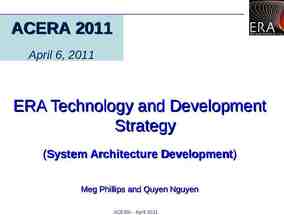Chapter 10: The Political Economy of Trade Policy Udayan Roy ECO 41
65 Slides1.26 MB

Chapter 10: The Political Economy of Trade Policy Udayan Roy ECO 41 International Economics

Contents The case for free trade The case against free trade Political models of trade policy International negotiations over trade policy and the World Trade Organization

Tariffs and quotas have deadweight losses and encourage rent-seeking; free trade allows largescale production, and provides more incentives for innovation; even when barriers to free trade make economic sense, these policies are often corrupted by interest groups ARGUMENTS FOR FREE TRADE

Free trade makes the world more efficient Scarce resources are used most efficiently when governments do not interfere with the way free markets work. – National welfare of a small country is highest under free trade. – Under restricted trade, consumers pay higher prices. – Under restricted trade, prices for domestic producers are artificially high. This causes overproduction either by existing firms producing more or by more firms entering the industry.

Fig. 10-1: The Efficiency Case for Free Trade As these efficiency gains from free trade are small—mostly because tariff rates are already quite low—they are not a persuasive argument for free trade. However, there are other arguments in favor of free trade Table 10-1: Benefits of a move to worldwide free trade (percent of GDP)

Free trade boosts dynamic efficiency Free trade allows firms to take advantage of economies of scale. – Example: In the auto industry, to operate at efficient scale, an auto plant should make a minimum of 80,000 cars per year. – In Argentina, under a protectionist regime in 1964, 13 firms produced a total of 166,000 cars per year. Free trade provides – Increased competition, and – Greater incentives for innovation.

Free trade reduces rent seeking Quotas can lead to rent seeking behavior that is economically wasteful – In India in the 1950s and 1960s, the amount of resources that a business was allowed to import was tied to how big the business was. This gave businesses an artificial incentive to over-invest and be big – Tuna importers to the United States were allowed to bring in a limited amount of tuna on a first-come-first-served basis. Tuna importers spent a lot of money to stockpile tuna in December, in order to be first in line in January – Such wasteful activities that are provoked by quirks in the laws are called rent seeking

Free trade keeps special-interest politics at bay Free trade is the best feasible political policy, even though there may be better policies in principle – We’ll soon see some examples where barriers to free trade may make economic sense – But such policies often require selective intervention – This opens the door to political squabbling Trade policies that single out certain industries for protection from imports are in practice dominated by special-interest politics rather than consideration of national costs and benefits.

Terms of trade argument and domestic market failure argument ECONOMIC ARGUMENTS AGAINST FREE TRADE

Terms of trade argument: optimum tariff For a “large” country, a tariff or quota lowers the price of imports in world markets and generates a terms of trade gain. – This benefit may exceed the losses caused by distortions in production and consumption. In fact, a small tariff will lead to an increase in national welfare for a large country. – But at some tariff rate, the national welfare will begin to decrease as the economic efficiency loss exceeds the terms of trade gain. – So the ideal or optimum tariff is greater than zero but less than the prohibitive tariff that stops all imports

Fig. 10-2: The Optimum Tariff

Terms of trade argument: optimum export tax An export tax (a negative export subsidy) that completely prohibits exports leaves a country worse off, but an export tax rate may exist that maximizes national welfare through the terms of trade effect. – An export subsidy lowers the terms of trade for a large country; an export tax raises the terms of trade for a large country. – An export tax may raise the price of exports in the world market, increasing the terms of trade.

Terms of trade argument: flaws The argument doesn’t work for small countries Even if a large country benefits from a tariff, that benefit comes at the expense of other countries. – The world as a whole would be worse off – This would invite retaliatory tariffs, in which case the tariff might hurt everybody

Domestic market failure argument The economic efficiency calculations using consumer and producer surplus that we have seen before assume that markets function well But markets can fail In such cases, the usual arguments for free trade may not work

Domestic market failure: examples Persistently high under-employment of workers – Labor surpluses that are not eliminated because wages do not adjust Persistently high under-utilization of structures, equipment and other forms of capital – Capital surpluses that are not eliminated because prices do not adjust Technological benefits for society discovered through private production, but from which private firms can not fully profit Environmental costs for society caused by private production, but for which private firms do not fully pay Property rights that are not well defined or well enforced Sellers that are not well informed about the (opportunity) cost of production or buyers that are not well informed about value from consumption

Domestic market failure argument for tariffs and quotas Figure 10-3: Production of a good yields extra social benefits—area (c) in panel (b)— not captured in producer surplus A tariff or quota can increase domestic output from S1 to S2. This might raise total surplus if the external social benefit (c) exceeds the deadweight loss (a b).

Domestic market failure argument: flaws A production subsidy would have the positive features of a tariff but not its negative features Because it is unclear when and to what degree a market failure exists in the real world, it is unclear when and to what degree government policies should respond Government policies to address market failures are likely to be manipulated by politically powerful groups

How special-interest groups that are against free trade can capture political power and the specialinterest groups that favor free trade are sidelined ANTI-TRADE POLITICS

Politics We have seen the arguments for and against free trade The case for free trade is very strong Yet actual national policies are often against free trade We need to understand the political process that leads to trade barriers

Political Theories of Trade Policy How is trade policy determined? Here are some theories: 1. Median voter theory 2. Collective action theory 3. A theory that combines aspects of the collective action and median voter theories

Median Voter Theory The median voter theorem predicts that democratic political parties may change their policies to court the voter in the middle of the ideological spectrum (i.e., the median voter). Suppose that voters differ only in their views on what the tariff rate should be

Median Voter Theory (cont.) The median voter theory assumes: – There are two competing political parties – Each party has to decide what the tariff rate should be – Voters differ in the tariff rates they prefer What policies will the two parties propose? – Answer: Both parties will support the tariff rate that the median voter (the voter who is exactly at the middle of the ideological spectrum) prefers

Median Voter Theory Fails The median voter theory cannot explain the widespread use of tariffs Those who benefit from a tariff are usually few in number compared to those who are hurt by the tariff Therefore, had the median voter theory been correct, tariffs would rarely have been enacted

Collective Action Theory Political activity is often described as a collective action problem This approach views political activity as a public good. – For instance, if one consumer’s letter to a politician helps to stop a tariff, all consumers would benefit – This encourages free riding Consequently, trade policies that impose large total losses that are spread among a large number of individual consumers may not face opposition. – Industries that are well organized (or have a small number of firms) will succeed in blocking foreign competition

Sugar Import Quota, 2013 The U.S. quota on sugar imports – Limits imports to 3 million tons under free trade, imports would be 66% higher – Keeps the U.S. price 35% above world price – Consumers lose 884 million annually – Producers gain 272 million annually – Overall loss to the U.S. is 612 million per year So, why do we have the sugar import quota?

Sugar Import Quota, 2013 The loss per consumer is only 3 per year. This is about 11 per family. As the U.S. sugar industry employs about 6,500 workers, the producers’ gains per employee is 42,000 per year. No wonder, the producers are politically organized and the consumers don’t bother! The final insult: without the quota, about 32% of the 6,500 workers would have had to look for jobs elsewhere. Thus, the cost to the consumer per job saved in the sugar industry is more than 432,000 per year.

Sugar Import Quota, 2013 Moreover, those who lose jobs in the sugar industry may well find jobs elsewhere Moreover, for every job “saved” in the sugar industry, economists have estimated that three jobs are lost in the confectionary manufacturing industry, because the sugar quota keeps sugar prices high

The political process In reality the median voter theory and the collective action theory may both be true While politicians may win elections partly because they advocate popular policies as implied by the median voter theory, they also require funds to run campaigns These funds may especially come from groups who do not have a collective action problem and are willing to advocate a special interest policy

Which Industries Are Protected? Agriculture: in the U.S., Europe, and Japan farmers make up a small fraction of the electorate but receive generous subsidies and trade protection. – Examples: European Union’s Common Agricultural Policy, Japan’s 1000% tariff on imported rice, America’s sugar quota. Clothing: textiles (fabrication of cloth) and apparel (assembly of cloth into clothing). – Until 2005, quotas licenses granted to textile and apparel exporters were specified in the Multi-Fiber Agreement between the U.S. and many other nations.

Protectionism: Agriculture in Japan

Table 10-2: Welfare Costs of U.S. Protection ( billion) 2002 Estimate 2015 Projected Total 14.1 2.6 Textiles and apparel 11.8 0.5 Source: U.S. International Trade Commission Until 2005, quota licenses granted to textile and apparel exporters were specified in the Multi-Fiber Agreement between the United States and many other nations. Phase-out of MFA drastically reduced the costs of U.S. protection, from 14.1b in 2002 (11.8b from textiles and apparel) to 2.6b estimate for 2015 (only 0.5b from textiles and apparel). Because the MFA assigned import licenses to exporting countries, most of the welfare cost to the US came not from distortion of production and consumption but from the transfer of quota rents to foreigners.

How export industries can be brought into politics on the side of free trade INTERNATIONAL NEGOTIATIONS OVER TRADE POLICY

International Negotiations over Trade Policy The average U.S. tariff rate on dutiable imports has decreased substantially since the 1930s.

Fig. 10-5: The U.S. Tariff Rate

International Negotiations over Trade Policy Since 1944, much of the reduction in tariffs and other trade restrictions came about through international negotiations. – The General Agreement of Tariffs and Trade was begun in 1947 as a provisional international agreement and was replaced by a more formal international institution called the World Trade Organization in 1995.

International Negotiations over Trade Policy Why did it take international negotiations? Why didn’t these countries reduce their tariffs unilaterally?

The Advantages of International Negotiations It is easier to lower tariffs as part of a mutual agreement than to do so as a unilateral policy because: – It helps mobilize exporters to support freer trade and speak up against the import-competing industries who oppose imports. – It can help governments avoid getting caught in destructive trade wars. – It reduces the possibility of an adverse terms-of-trade effect from a unilateral reduction of tariffs.

Multilateral negotiations: the export industries enter the fight! Multilateral negotiations mobilize exporters to support free trade if they believe that their export markets will expand when other countries reciprocate by embracing free trade. – This support would be lacking in a unilateral push for free trade. – This support counteracts the support for restricted trade by import-competing groups.

Bilateral Trade Liberalization Suppose the USA and Brazil currently impose tariffs on each other’s goods and cannot unilaterally remove the tariffs because of the political power of US coffee growers and Brazilian wheat farmers When bilateral negotiations begin, the US coffee growers’ (or, Brazilian wheat farmers’) resistance to free trade would be opposed by US wheat farmers (or, Brazilian coffee growers) eyeing a possible reduction of Brazil’s (or, the US’s) tariffs on US wheat (or, Brazilian coffee). In this way, bilateral negotiations to reduce tariffs can succeed even when unilateral efforts fail. USA Wheat Coffee Brazil

Multilateral Trade Liberalization In this example, bilateral negotiations between, say, Angola and Brazil will not succeed in reducing tariffs. – As Brazil does not export coffee to Angola, there will be no opposition to Brazilian oil producers’ demands for a tariff on Angolan oil. However, a multilateral agreement will be successful. In each country, exporters will organize to oppose importers’ resistance to the multilateral agreement. China Wheat Angola Coffee Oil Brazil

Multilateral Trade Liberalization Another reason why multilateral deals may be more successful has to do with the adverse terms of trade effect of tariff reduction Suppose the USA is a big importer of coffee A cut in tariffs by USA would raise worldwide coffee prices and this would hurt the USA Therefore, unilateral tariff reduction by the USA is unlikely ( continued next slide)

Multilateral Trade Liberalization But if the coffee exporters reciprocate by reducing their tariffs on the goods that the US exports, then a deal becomes possible In this way, multilateral trade liberalization is more likely to happen than unilateral trade liberalization

Multilateral negotiations: trade wars avoided Multilateral negotiations also help avoid a trade war between countries, where each country enacts trade restrictions. A trade war could result if each country has a political interest (due to political pressure) to protect domestic producers, regardless of what other countries do. – All countries could enact trade restrictions, even if it is in the interest of all countries to have free trade. Let’s use a simple example to illustrate this point.

Multilateral negotiations: trade wars avoided TABLE 10-3 Dominant strategy for Japan Dominant strategy for USA

Multilateral negotiations: trade wars avoided In Table 10-3, each country would choose protection even though each country would be better off if both chose free trade. – In game theory, this situation is known as a prisoners’ dilemma. Is there a way out of the prisoners’ dilemma in trade policy?

Multilateral negotiations: trade wars avoided Japan and the U.S. can establish a binding agreement to maintain free trade and thereby escape the prisoners’ dilemma.

History: Bilateral versus Multilateral USA imposed the Smoot-Hawley tariffs in 1930 Widely recognized to be a mistake that worsened the Great Depression But unilateral tariff reduction was politically difficult Initially bilateral tariff-reducing agreements were pursued Later multilateral agreements became popular

International Negotiations and Trade Policy: History International trade negotiations began after World War II The initial agreement among 23 major countries was called the General Agreement on Tariffs and Trade (GATT) In 1995 the World Trade Organization (WTO) was established to organize further negotiations

The GATT-WTO system The GATT-WTO system tries to reduce trade restrictions in 3 main ways: 1. Reduction of tariff rates through multilateral negotiations. 2. Binding: a tariff is “bound” by having the imposing country agree not to raise it in the future. 3. Prevention of non-tariff barriers: quotas and export subsidies are changed to tariffs because the costs of tariff protection are more apparent. Subsidies for agricultural exports are an exception. Exceptions are also allowed for “market disruptions” caused by a sudden surge in imports. Successive “rounds” of negotiations are held to gradually reduce trade barriers

World Trade Organization (cont.) The World Trade Organization was founded in 1995 after a number of agreements – General Agreement on Tariffs and Trade: covers trade in goods – General Agreement on Tariffs and Services: covers trade in services (ex., insurance, consulting, legal services, banking). – Agreement on Trade-Related Aspects of Intellectual Property: covers international property rights (ex., patents and copyrights).

World Trade Organization (cont.) The dispute settlement procedure: a formal procedure where countries in a trade dispute can bring their case to a panel of WTO experts to rule upon. – The cases are settled fairly quickly: even with appeals the procedure is not supposed to last more than 15 months. – The panel uses previous agreements by member countries to decide which ones are breaking their agreements. – A country that refuses to adhere to the panel’s decision may be punished by allowing other countries to impose trade restrictions on its exports.

WTO: US v. Venezuela US laws allowed domestic oil refineries to sell oil with more pollutants than imported oil Venezuela, which exports oil to the US, sued the US at the WTO Venezuela won. The US had to change its laws to make them non-discriminatory This episode showed that the WTO worked Environmentalists complained that the WTO made it harder for the US to reduce pollution Actually, the fault lies with the US law. The WTO should not be blamed

World Trade Organization (cont.) In 2001, a new round of negotiations was started in Doha, Qatar, but these negotiations have failed to produce an agreement. – Most of the remaining forms of protection are in agriculture, textiles and clothing—industries that are politically active

Table 10-4: Percentage Distribution of Potential Gains from Free Trade

Do Agricultural Subsidies in Rich Countries Hurt Poor Countries? We learned in chapter 8 that subsidies lower the world price of products because domestic producers are enticed to produce more. – So why should poor countries want rich countries to remove their agricultural subsidies? – The likely answer has to do with the desires of farmers in poor countries who compete with farmers in rich countries. – Yet, urban residents and farmers who do not compete (e.g., coffee farmers) actually benefit from the lower prices of subsidized food on world markets. For example, because China imports a lot of food, it would be hurt by the removal of agricultural subsidies in rich countries (e.g., the U.S. and Europe) according to the Doha negotiations.

Table 10-5: Percentage Gains in Income under Two Doha Scenarios

Preferential Trading Agreements Preferential trading agreements are trade agreements between countries in which they lower tariffs for each other but not for the rest of the world. Under the WTO, such discriminatory trade policies are generally not allowed: – Each country in the WTO promises that all countries will pay tariffs no higher than the nation that pays the lowest: called the “most favored nation” (MFN) principle. – An exception to this principle is allowed only if the lowest tariff rate is set at zero.

Preferential Trading Agreements (cont.) There are two types of preferential trading agreements in which tariff rates are set at or near zero: 1. A free trade area: an agreement that allows free trade among members, but each member can have its own trade policy towards non-member countries – An example is the North America Free Trade Agreement (NAFTA).

Preferential Trading Agreements (cont.) 2. A customs union: an agreement that allows free trade among members and requires a common external trade policy towards nonmember countries. – An example is the European Union.

Preferential Trading Agreements (cont.) Are preferential trading agreements necessarily good for national welfare? No, it is possible that national welfare decreases under a preferential trading agreement. How? Rather than gaining tariff revenue from inexpensive imports from world markets, a country may import expensive products from member countries but not gain any tariff revenue.

Preferential Trading Agreements (cont.) Preferential trading agreements increase national welfare when new trade is created, but not when existing trade from the outside world is diverted to trade with member countries. Trade creation – occurs when high cost domestic production is replaced by low cost imports from other members. Trade diversion – occurs when low cost imports from non-members are diverted to high cost imports from member nations.

Trade Diversion in South America Argentina, Brazil, Paraguay, and Uruguay formed a free trade area in 1991 called Mercosur Within four years, trade among these countries tripled A 1996 World Bank study, however, argued that this trade creation was probably exceeded by trade diversion, and that the overall effect of Mercosur was probably negative – Argentina began importing Brazilian cars because those inefficiently produced cars faced no tariffs – Had Argentina imported other cars, it could have earned large tariff revenues









